This Journey takes us through some of Botswana’s and Zimbabwe’s magnificent game reserves. Starting and ending at the spectacular Victoria Falls. Just some of the highlights of this trip include a game drive in Hwange National Park, the Moremi Game Reserve, Greater Khwai, a 2-day Okavango Delta excursion and the Chobe National Park, as well as the Caprivi Strip.
Departs: Victoria Falls, Zimbabwe.
Ends: Victoria Falls, Zimbabwe.
Group size: Guaranteed from 4 guests; 12 guests maximum. *Guaranteed departures with no minimum pax available, please enquire.
Summary
A small group lodge safari, starting and ending in Victoria Falls through Zimbabwe, Botswana and Namibia.
Highlights
Hwange National Park, Nata Bird Sanctuary, Game Drives in the Moremi National Park & Khwai, Okavango Delta experience including Mokoro excursion, Bwabwata National Park, Eastern Caprivi, Game drive in Chobe National Park, Sunset cruise on the Chobe River, Victoria Falls.
Meals
14x Breakfast, 11x Lunch, 12x Dinner. Where included most breakfasts and dinners will be enjoyed in the restaurants of the various accommodation establishments, however on certain nights the guide will provide an authentic meal for the group, which will be enjoyed together in the evening, often around a camp fire. Please advise us of any special dietary requirements in advance.
SAFARI
COST: $3,440 per person sharing, plus local payment of USD 350 (in cash).
SINGLE SUPPLEMENT: $1,175 |
CLICK TO SEE DEPARTURE DATES
|
|
DAY 1;
(1 Night)
VICTORIA FALLS, Zimbabwe [Lodge] |
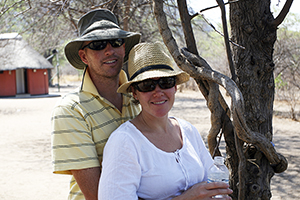 On arrival into Victoria Falls Airport, you will be met and transferred to your hotel. The rest of the afternoon may be spent at leisure enjoying one of the many activities available in Victoria Falls. This evening you will meet your guide and the rest of your group at the lodge at 18h00 for your pre-departure meeting. On arrival into Victoria Falls Airport, you will be met and transferred to your hotel. The rest of the afternoon may be spent at leisure enjoying one of the many activities available in Victoria Falls. This evening you will meet your guide and the rest of your group at the lodge at 18h00 for your pre-departure meeting.
|
Distance / Time: N/A
Overnight: A'Zambezi River Lodge or similar (rooms with en suite
bathrooms, swimming pool, bar & restaurant).
Meals: All meals at your own account.
|
DAYS 2 - 4;
(3 Nights)
VICTORIA FALLS TO HWANGE NATIONAL PARK, Zimbabwe [Chalets] |
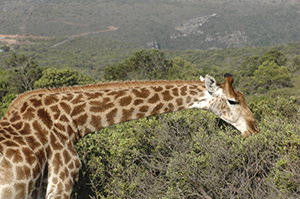 This morning we depart Victoria Falls and make our way to our lodge in a private concession near to Hwange National Park. The next days are spent exploring this wildlife rich area. This afternoon you can partake in an optional game drive if time allows. Over the following two days, we will have plenty of time to explore this vast wilderness on game drives. Hwange National Park is one of Africa's finest havens for wildlife and is home to vast herds of elephant, buffalo, and zebra and has a very large concentration of giraffe. It is also home to many predators and endangered species plus varied birdlife. We will also visit the Painted Dog Conservation Centre to witness the work that is done to protect these endangered species. This morning we depart Victoria Falls and make our way to our lodge in a private concession near to Hwange National Park. The next days are spent exploring this wildlife rich area. This afternoon you can partake in an optional game drive if time allows. Over the following two days, we will have plenty of time to explore this vast wilderness on game drives. Hwange National Park is one of Africa's finest havens for wildlife and is home to vast herds of elephant, buffalo, and zebra and has a very large concentration of giraffe. It is also home to many predators and endangered species plus varied birdlife. We will also visit the Painted Dog Conservation Centre to witness the work that is done to protect these endangered species.
|
Departure: 8am
Distance / Time: 190 kms (day 2)
Overnight: Sable Sands or similar (chalets with en-suite bathroom, swimming pool & bar area).
Meals Day 2: A'Zambezi River Lodge or similar, Lunch at Sable Sands or similar or similar, Dinner at Sable Sands or similar or similar.
Meals Day 3: Breakfast at Sable Sands or similar, Lunch pack on Game Drive, Dinner at Sable Sands or similar.
Meals Day 4: Breakfast at Sable Sands or similar, Lunch at Sable Sands or similar, Dinner at Sable Sands or similar.
|
DAY 5;
(1 Night)
HWANGE NATIONAL PARK TO NATA LODGE, Botswana [Permanent Safari Tents] |
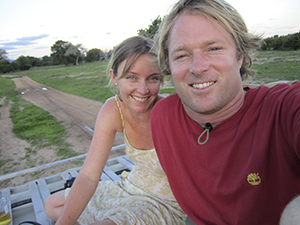 We need to get up early, as today is our longest drive of the safari. We leave Hwange National Park and drive through the Matetsi safari area en-route to Botswana. The drive is beautifully scenic, with the chance of spotting game along the way. We arrive into Nata Lodge in the late afternoon. We need to get up early, as today is our longest drive of the safari. We leave Hwange National Park and drive through the Matetsi safari area en-route to Botswana. The drive is beautifully scenic, with the chance of spotting game along the way. We arrive into Nata Lodge in the late afternoon.
|
Departure: 6am
Distance / Time: 420 kms
Overnight: Nata Lodge or similar (permanent safari tents with en suite
bathrooms, swimming pool & bar).
Meals: Breakfast at Sable Sands or similar, Lunch prepared by guide en-route, Dinner prepared by the guide. |
DAY 6; (1 Night)
NATA BIRD SANCTUARY AND KHWAI, Botswana [Semi Permanent Tented Camp] |
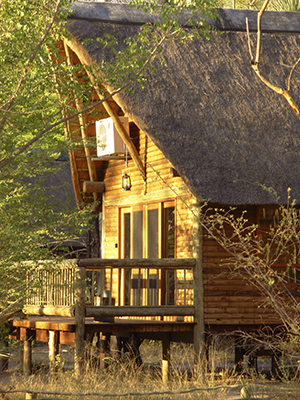 After breakfast we head off to the Nata Bird Sanctuary, where we get the opportunity to enjoy the magnificent view over the Sowa pan, which is part of the Greater Makgadikgadi Pans. (Please note a visit to the pans is subject to the road conditions and water levels as well as time constraints.) After breakfast we head off to the Nata Bird Sanctuary, where we get the opportunity to enjoy the magnificent view over the Sowa pan, which is part of the Greater Makgadikgadi Pans. (Please note a visit to the pans is subject to the road conditions and water levels as well as time constraints.)
We make our way to our camp, which is situated in a private concession in the Khwai River area. This large area is renowned for its concentration of mammals and it is not unusual to see many different types of wildlife during just one game drive. Game viewing is seasonal; depending on the time of the year you may see different species in different areas. The best time for game viewing is the end of the dry season or spring from August to November. During this season, in order for us to offer the best game viewing possible, extra driving may be required due to the animals migrating closer to the river. In the summer, birdlife can also be viewed in abundance with exceptional sightings of wildfowl and raptors. |
Departure: 8am
Distance / Time: 450 kms
Overnight: Khwai Bedouin Camp or similar (semi-permanent tented camp with en-suite bathrooms). Please note that there is no electricity at the camp.
Meals: Breakfast at Nata Lodge or similar, Lunch prepared by guide en-route, Dinner at Khwai Bedouin Camp or similar. |
DAY 7;
(1 Night)
KHWAI RIVER, Botswana [Semi-permanent Tented Camp] |
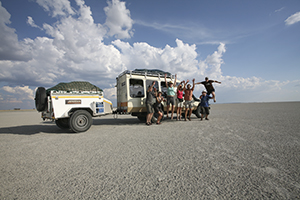 We have the opportunity to spend the day on game drives. In our open 4x4 vehicle we will explore the Khwai River region on morning and afternoon game drives hopefully spotting a variety of game that frequent this region. After dinner your guide will take you on a night drive, and you will hopefully be able to spot some rare nocturnal animals. We have the opportunity to spend the day on game drives. In our open 4x4 vehicle we will explore the Khwai River region on morning and afternoon game drives hopefully spotting a variety of game that frequent this region. After dinner your guide will take you on a night drive, and you will hopefully be able to spot some rare nocturnal animals.
|
Departure: 7am
Distance / Time: 150 kms
Overnight: Khwai Bedouin Camp or similar (semi-permanent tented camp with en-suite bathrooms).
Meals: Breakfast at Khwai Bedouin Camp, Lunch at Khwai Bedouin Camp, Dinner at Khwai Bedouin Camp. |
DAY 8; (1 Night)
MOREMI GAME RESERVE, Botswana [Semi-permanent Tented Camp] |
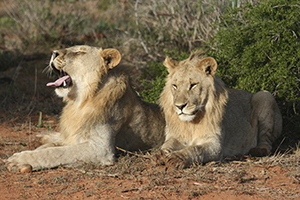 Today we head into the famous Moremi Game Reserve known as one of the most beautiful and varied reserves in Africa with an unprecedented concentration of wildlife. The full day is spent in the unspoiled nature of the Moremi Game Reserve. Today we head into the famous Moremi Game Reserve known as one of the most beautiful and varied reserves in Africa with an unprecedented concentration of wildlife. The full day is spent in the unspoiled nature of the Moremi Game Reserve.
|
Departure: 7am
Distance / Time: 150 kms
Overnight: Khwai Bedouin Camp or similar (semi-permanent tented camp with en-suite bathrooms).
Meals: Breakfast at Khwai Bedouin Camp, Lunch pack on Game Drive, Dinner at Khwai Bedouin Camp. |
DAYS 9 - 10; (2 Nights)
OKAVANGO DELTA, Botswana [Permanent Tents] |
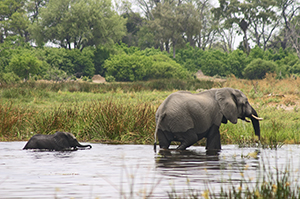 An early departure for Etsha 13, on the western border of the Okavango Delta in Botswana. Unlike other deltas, it flows into the Kalahari Desert without reaching the coast, which makes it unique. The next day is spent exploring the network of water pathways through thick vegetation in mokoros (traditional dugout canoes), discovering a variety of birds and wildlife. We have the opportunity to stop at a secluded island to take a 1½ hour guided walk hoping to spot elephants, waterbuck or other animals living in this water filled paradise. An early departure for Etsha 13, on the western border of the Okavango Delta in Botswana. Unlike other deltas, it flows into the Kalahari Desert without reaching the coast, which makes it unique. The next day is spent exploring the network of water pathways through thick vegetation in mokoros (traditional dugout canoes), discovering a variety of birds and wildlife. We have the opportunity to stop at a secluded island to take a 1½ hour guided walk hoping to spot elephants, waterbuck or other animals living in this water filled paradise.
|
Departure: 6am
Distance / Time: 395 kms
Overnight: Guma Lagoon Camp or similar (permanent tents with en suite
bathroom, bar area).
Meals Day 9: Breakfast at Khwai Bedouin Camp or similar, Lunch prepared by the guide en-route, Dinner at Guma Lagoon Camp or similar.
Meals Day 10: Breakfast at Guma Lagoon Camp or similar or similar, Lunch pack on Mokoro excursion, Dinner prepared by the guide. |
DAY 11; (1 Night)
MAHANGU, Namibia [Chalets] |
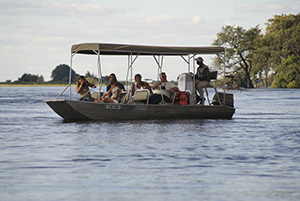 Today after our Delta experience we leave the lush verdant wetlands of Botswana and enter Namibia. Enjoy an afternoon game drive in the Greater Bwabwata National Park, which extends from the Kavango River in the west to the Kwando River in the east and incorporates the Mahangu Game Reserve. Elephant, roan, kudu and buffalo are amongst the animals likely to be seen as well as prolific birdlife. Today after our Delta experience we leave the lush verdant wetlands of Botswana and enter Namibia. Enjoy an afternoon game drive in the Greater Bwabwata National Park, which extends from the Kavango River in the west to the Kwando River in the east and incorporates the Mahangu Game Reserve. Elephant, roan, kudu and buffalo are amongst the animals likely to be seen as well as prolific birdlife.
|
Departure: 8am
Distance / Time: 180 kms
Overnight: Mahangu Lodge or similar (chalets with en-suite
bathrooms, swimming pool & bar).
Meals Day 11: Breakfast at Guma Lagoon Camp or similar, Lunch prepared by the guide en-route, Dinner at Mahangu Lodge or similar. |
DAYS 12 - 13; (2 Nights)
MAHANGU NATIONAL PARK TO CHOBE NATIONAL PARK, Namibia [Lodge] |
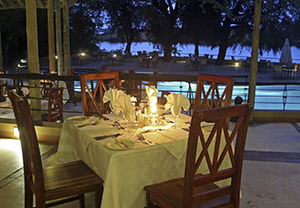 After a night spent at Mahangu Lodge we continue our journey through the Caprivi Strip, crossing the border back into Botswana until we reach our destination, Kasane, the gateway to the Chobe National Park. Start your morning of Day 13 with a hopefully spectacular game drive in Chobe National Park. You will return to the lodge for a late breakfast and relaxation until our boat cruise on the Chobe River starts around 3pm. Here we can watch elephants, hippos, crocodiles and a variety of birds, making for excellent up close photo opportunities. After a night spent at Mahangu Lodge we continue our journey through the Caprivi Strip, crossing the border back into Botswana until we reach our destination, Kasane, the gateway to the Chobe National Park. Start your morning of Day 13 with a hopefully spectacular game drive in Chobe National Park. You will return to the lodge for a late breakfast and relaxation until our boat cruise on the Chobe River starts around 3pm. Here we can watch elephants, hippos, crocodiles and a variety of birds, making for excellent up close photo opportunities.
|
Departure: 8am
Distance / Time: 455 kms
Overnight: Chobe Safari Lodge or similar (rooms with en-suite bathrooms, swimming pool, bar & restaurant).
Meals Day 12: Breakfast at Mahangu Lodge or similar, Lunch prepared by the guide, Dinner at Chobe Safari Lodge or similar.
Meals Day 13: Breakfast at Chobe Safari Lodge or similar, Lunch on your own account, Dinner at Chobe Safari Lodge or similar. |
DAY 14; (1 Night)
VICTORIA FALLS, Zimbabwe [Guesthouse] |
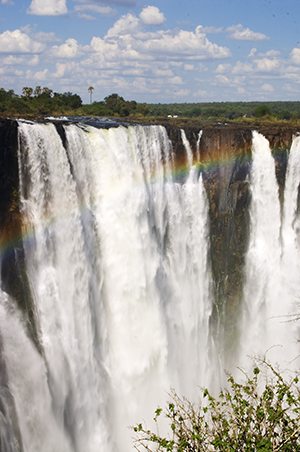 Today we leave Botswana behind us and come to the place where we started this trip full of real African experiences – Victoria Falls. We visit the Victoria Falls on a guided tour and then have the rest of the day at leisure or to partake in one of the many optional activities. (For own expense). Today we leave Botswana behind us and come to the place where we started this trip full of real African experiences – Victoria Falls. We visit the Victoria Falls on a guided tour and then have the rest of the day at leisure or to partake in one of the many optional activities. (For own expense).
|
Departure: 8am
Distance / Time: 110 kms
Overnight: A'Zambezi River Lodge or similar (rooms with en-suite bathrooms, swimming pool, bar & restaurant).
Meals: Breakfast at Chobe Safari Lodge or similar, Lunch on your own account, Dinner on your own account. |
DAY 15;
VICTORIA FALLS, Zimbabwe [TOUR ENDS] |
Our safari ends after breakfast. You will be transferred to Victoria Falls Airport in time for your departure flight. We hope to welcome you again one day on another of our African adventures. |
Departure: N/A
Distance / Time: N/A
Overnight: N/A
Meals: Breakfast at A'Zambezi River Lodge or similar.
|
Note: The accommodation specified in the itinerary is a guide only and is subject to availability. Alternatives will be nearby and of a similar standard.
 Top Top
CLICK TO SEE DEPARTURE DATES
Included
Fourteen nights in fixed accommodation, all transport in appropriate vehicle, game drives as mentioned, meals and activities as mentioned in itinerary, park entrance fees, experienced local guide.
Excluded
Travel insurance, flights, pre and post tour accommodation, optional activities, all drinks, telephone calls, gratuities, curios and all personal expenses.
Departure
The Botswana Wildlife Breakaway Safari departs from A’Zambezi River Lodge or similar.
Please note that the daily departure times are a guideline only and are subject to
change due to seasonal variations, as well as unforeseen circumstances. The final
decision rests with your guide who will advise you at what time you will be departing
each day.
On the evening of day 1, there will be a meeting presented by your guide, at 6pm, at your lodge. It is imperative that all clients attend this meeting so as not to miss out on any critical information. Whilst it is our every intention to adhere to the above mentioned itinerary, there may on occasion be a necessity to make alterations in order to make the tour more enjoyable or practical. Therefore please treat the itinerary as a guide only.
Transport
We use fully equipped 12-seater 4x4 safari vehicles or other appropriate vehicles with comfortable seating, large windows for game viewing, a music and PA system and air -conditioning. All luggage, besides hand luggage and photo equipment, is carried on the vehicle or trailer roof racks to ensure maximum comfort in the vehicle. Some game drives may be conducted in open-sided safari vehicles. For transfers between Kasane and Victoria Falls or Hwange and Victoria Falls (or vice versa), 2x4 vehicles may be utilised.
Local Payment
A local payment is required on your safari and will be collected by your guide on the day of departure. The local payment is part of the overall tour cost and is used to pay some of the day to day operational costs that are incurred while we are on the road. We try to prepay as many of the costs as possible however in some cases cash payment on arrival is the only option as some of the attractions we visit on safari only accept cash. Examples include park fees at most of the national parks, a few accommodations or camp sites and any local food markets we visit to stock up on fresh produce during the tour as well as local guides. Your tour guide is given a garage card to pay for fuel, however this is only valid for use in South Africa and certain parts of Namibia therefore any other fuel purchases also need to be paid for in cash.
Travelling Times and Distances
All travelling times are affected by road conditions, border crossings, detours and weather conditions, therefore on certain days travelling times may be longer than anticipated especially where there is a lot of distance to be covered. Please keep in mind that the time it takes to travel 100 km in your home country is not equivalent to the time it takes to travel 100 km on African roads, therefore we encourage you to sit back and enjoy the spectacular scenery Africa has to offer. Where possible additional stops will be made to ensure your travelling comfort at all times.
Accommodation
We make use of mid-range typical African standard lodge accommodation. Accommodation is situated either in national parks, on the banks of a river, or in other places of interest. The accommodation will be a mix of lodges, chalets and tented camps with en-suite bathrooms.
Visas
The onus is on the client to organize all visas required to visit the countries stated on the itinerary. Kindly remember that clients would require a multiple entry visa for Zimbabwe & Botswana should they partake on our Botswana Wildlife Breakaway scheduled tour.
Information on Areas Visited
ZIMBABWE
This is a country blessed with great natural beauty, game reserves and mineral wealth. The diverse landscape changes from mountainous to wilderness to typical Bushveld. The
country is also home to large animals and a large bird population. Zimbabwe is a country
located in the southern part of the continent of Africa, between the Victoria Falls,
Zambezi River, Kariba Dam and the Limpopo River. Zimbabwe is bordered by South
Africa to the south, Botswana to the west, Zambia to the north and Mozambique to the
east.
Victoria Falls
'So lovely it must have been gazed upon by angels in their flight' said David Livingstone
of the supreme Mosi-oa-Tunya ('The smoke that thunders'). This legendary traveler first
saw the falls from the Zambian side and his memory is enshrined in the nearby town of
Livingstone. The views from the Zimbabwean & Zambian side are quite different, varying
dramatically depending on the season and water flow.
The Falls are over a mile in length and boast the largest curtain of water in the world -
over 500 million litres of water per minute cascade over the falls and drop 100 m at
Rainbow Falls on the Zambian side. Not surprisingly is it the seventh natural wonder of the
world and fast becoming one of the top adventure destinations in the world.
The river is divided into a series of braided channels that descend in many separate falls.
Below the falls the river enters a narrow series of gorges, which represent locations
successively occupied by the falls earlier in their history. Since the uplifting of the
Makgadikgadi Pan area some two million years ago, the Zambezi River has been cutting
through the basalt base rock, exploiting weak fissures, and forming a series of retreating
gorges. Seven previous waterfalls occupied the seven gorges below the present falls,
and Devil's Cataract in Zimbabwe is where the next cut back will form a new waterfall
that will eventually leave the present falls lip high above the river in the gorge below.
Hwange National Park
Hwange National Park is one of Africa's finest havens for wildlife and is home to vast
herds of elephant, buffalo, and zebra and has a very large concentration of giraffe. It is
also home to many predators and endangered species plus very large and varied
birdlife.
The park is situated on the main road between Bulawayo and the world famous Victoria Falls. Hwange National Park covers just over 14 600 square kilometers. The Park carries
105 mammal species, including 19 large herbivores and eight large carnivores. Elephant
make up the largest proportion of the biomass.
All Zimbabwe's specially protected animals are to be found in Hwange and it is the only
protected area where gemsbok and brown hyena occur in reasonable numbers. The
population of wild dog to be found in Hwange is thought to be of one of the largest
surviving groups in Africa today.
The landscape includes desert sand to sparse woodland as well as grasslands and
granite outcrops. Due to the lack of water, man-made waterholes were introduced to
sustain the animals through the dry season. The park has an interesting variety of
landscapes with one part running alongside the North-eastern end of the Kalahari
Desert. The south is sandy with extensive forests and open grassland. A feature of the
area is ancient fossil dunes - ancient sand dunes held together by vegetation.
BOTSWANA
The San were among the first human inhabitants of this region before the Setswana migrated southwards and slowly occupied the region from the 16th century onwards, until early in the 19th century. By mid-century missionaries arrived, including David Livingstone and Robert Moffat, and by 1885 the territory was a British protectorate. Botswana gained its independence in 1966 and has been the most stable democracy in Africa. The first president ruled from 1966 until his death in 1980, the second till 1994 (re-elected twice, then resigned) and the third from 1998.
The country has a strong currency with one of the highest per capita incomes in Africa,
maintains a neutral international political stance. It is heavily reliant on mining (especially
diamonds) & tourism and maintains close ties with its neighbor South Africa, an economic
powerhouse for the region.
Wildlife is abundant in Botswana and includes lion, giraffe, leopard, antelope, elephant, crocodile and ostriches. Botswana is semiarid and has an average annual (summer)
rainfall of 640 mm (about 25 in) in the north to less than 230 mm (less than 9 in) in the
Kalahari. Drought is therefore not uncommon and the vegetation is mostly savannah.
Geographically Botswana is relatively flat (the average elevation of about 1000 m) and
can be viewed (for all intents and purposes) as three major regions as follows:
Chobe National Park in the north, another outstanding wilderness area of enormous
diversity – lion and elephant can be viewed from river cruises or 4x4 game drives.
The Okavango Delta is a vast marshland and one of the largest inland river deltas in the
world – 15 000 km2 of wilderness and prime safari area. The Kalahari Desert in the central
and southwestern regions occupies over half the land area of Botswana. It is a mystical,
harsh and unspoiled landmass. The saltpans of north-central Botswana and the Tuli block in the far eastern corner of
Botswana are also areas of significance.
Chobe National Park
Chobe is approx. 11 000 km2 of wilderness area watered by the Chobe & Savuti Rivers
and thus attracting huge concentrations of game. This includes lion and some of the
highest concentration of elephant in Africa – an estimated population of around 25 000
in winter. Game viewing is renowned and in the Northern areas near Kasane, both the
riverboat game viewing experience and the 4x4 vehicle option are popular.
In addition the spectacular annual summer migrations of plains game, especially Zebra,
is a highlight, as well Giraffe, Warthog and numerous antelope including Sable, Roan,
Oribi, Reedbuck, Lechwe and the colourful Chobe Bushbuck.
Bird watching opportunities in Chobe are ample and include some 350 species including
the awesome African Fish Eagle, the rare Pell's Fishing Owl, saddle-billed storks, long-toed
Plovers, pink-backed Pelicans, African Skimmers, Bradfield's Hornbills and Carmine Beeeaters. In addition, the sunsets are spectacular.
Makgadikgadi Pans
The lesser-known Makgadikgadi Pans National Park is situated between Maun and Nata
in Botswana. The shimmering saltpans of Makgadikgadi are the size of Switzerland and
most of the time appear as a glaring, white, endless plain. When the rain comes a
dramatic change takes place as the pans come to life with frantically feeding water
birds and great herds of game. The best time to visit this area to coincide with the
migration is from December to March or in the dry season from April to October when
the pans are dry.
The park contains four main vegetation types: riverine woodland, scrubland, pure
grassland and saltpans. The pans support palm groves and peculiar looking Baobab
trees whose branches look more like roots, giving rise to the name 'upside down tree'.
These are interspersed with short spiky yellow grass found on rises between the pans,
known as 'prickly salt grass'. This grass is extremely saline resistant to the extent that salt
crystals can sometimes be seen on the leaves. The interior of the reserve comprises scrub
and grassland with a few 'islands' of Real Fan Palms and Camel-thorn Acacia.
From April to November game such as Springbok, Gemsbok, Wildebeest and Zebra
move slowly from the pans area in the south east of the park, to the Boteti River in the
west. During this migration animals accumulate in their thousands. The heavily wooded
areas beside the river also contain shy antelopes like Duiker and Bushbuck.
Maun
Maun is the gateway to the Okavango Delta and one of the best safari experiences you
will have. Countless safari and air-charter operators have offices here, thus it is busy with
people coming and going especially around the airport. The best time to go is during the
winter months from May to October when there is little or no rainfall and the days are
warm and cloudless. Nights can be cold though so take a jacket. November to April can
be very hot, with most of the rainfall between December and February.
Maun has developed rapidly from a rural frontier town and has spread along the wide
Thamalakane River. It now boasts good shopping centers, hotels and lodges as well as
car and 4x4 vehicle hire. However, it still retains a rural atmosphere and local tribesmen
still bring their cattle here to sell and you could see antelopes grazing the riverbanks.
Moremi
In the centre of the Okavango Delta is the Moremi Wildlife Reserve, a 3,000 km2 paradise.
Proclaimed a wildlife reserve by the Tswana people in 1963, Moremi is undoubtedly one
of the world's most pristine wilderness areas. The foresight of the local community has
ensured that nature has flourished undisturbed, offering a glimpse of the divine, averitable Garden of Eden. Moremi is a place of lily-covered wetlands, grass plains and forests, where even at the busiest time of year you're likely to be the only spectators at a most dramatic animal sighting. Moremi consists of a network of waterways surrounding two large islands, Chiefs Island in
the west and Mopane Tongue in the east. The area's diverse ecosystems, riverine
woodland, flood plains, wetlands and reed beds, mopane forest and dry savannah
woodland are all flourishing, broken only by the occasional jeep track. This diversity of
habitats provides rich pickings for an impressive variety of animals and around 550 bird
species. As Moremi is a fenced reserve, game viewing is impressive throughout the year.
However, the cool dry winter months from March to September are an ideal time to visit,
as the chances of seeing lion, elephant, leopard, hyena, eland, kudu, roan antelope,
giraffe, zebra, impala and buffalo are excellent. On the sandy riverbanks and wetlands,
sightings of hippo and crocodile are commonplace.
Okavango Delta
The Okavango Delta in northern Botswana (near Maun) incorporates the Moremi Game
Reserve and is a unique wildlife paradise - one of the finest in the world. It is also one of
the largest inland river deltas in the world. This unsurpassed natural environment is a maze
of waterways, islands and reed banks creating a perfect habitat for lion, elephant,
leopard, buffalo, giraffe, hyena, wild dog, kudu, impala, roan, zebra, lechwe, hippo and
crocodile, amongst others. There are approx 440 bird species in the delta and fish
species are also abundant, including tiger fish, sharp-toothed catfish, barbell and bream.
Travel through the swamps and surrounding areas is generally done by open 4x4 game
viewing vehicle or a peaceful meander in a 'Mokoro', a flat-bottomed dugout canoe.
The Delta is hot throughout the year with temperatures ranging from approx 14°C in
January to 24°C in July. Rainfall averages 525 mm annually, but varies greatly from year
to year. Water levels and flooding reach a maximum between March and July, after
rains at the source and the usual 15 000 km2 can expand to approximately 22 000 km2 in
high-rainfall years.
NAMIBIA
'Namibia' means 'open plains' in the ancient Hottentot language. It is a popular tourist destination defined by endless sunshine, scenic beauty and unusual and contrasting
topography. Namibia is sandwiched between two deserts - the Namib Desert, said to be
the oldest in the world, on its western coastline and the Kalahari Desert in the eastern
interior. Northern Namibia features the great Etosha National Park of approx 22,000km2,
with the countries largest concentration of game and in the south the majestic Fish River
Canyon plunges 550 m and extends for 160 km. Between these four highlights lies over
820 000 km2 (the size of France & Britain combined) of contrasting scenery.
The world's highest dunes are found in haunting scenery inspiring somber reflection. Prehistoric
rock art, the ancient fossil plant, Welwitschia mirabilis and fossilized dinosaur
footprints are preserved in the ancient rocky mountain ranges.
Many of the features of this country are of particular scientific interest and attract
scientists from all over the world. Namibia is the first country in the world to include
protection of the environment and sustainable utilization of wildlife in its constitution.
Approx 15,5% of the country has been set-aside as national park. In these areas, rare and endangered species of animals, birds and plant life are preserved and protected. They
serve as a living reminder to us all, and to the generations of the future, of how it once
was in Africa.
Bwabwata National Park – Mahango Game Reserve
Located in the north east of Namibia on the Botswana border, the contrasting
vegetation of the 25 400 hectare Mahango Game Reserve is widely considered one of
Namibia' s most varied and fascinating conservation areas.
There are three distinct habitats that can be identified, the river, which offers a blend of
trees, reeds and grasses along its banks and on the wetlands. One tree that you will
quickly recognize is the baobab. The Omurambas, which are fossil rivers, are covered
with open grassland with tall acacia and bushwillow around the borders. Year round
water ensures an abundance of game, however, during the dry winter months, April -
November, your chances of seeing game is higher as the animals seek out the river and
waterholes. Mahango is home to many antelope, if you are fortunate you may spot;
roan, sable, reedbuck, tsessebe, sitatunga, red lechwe, kudu, Chobe bushbuck , Duiker
and Steenbok. If you are lucky you will also see elephant, lion, leopard, cheetah,
wildog, hippo and crocodile. During the wet summer months, November-March, birdlife
is prolific. After it rains various trees flower and bear fruit attracting an abundance of
insects and creating a birding paradise. Over 400 bird species have been recorded in
the Mahango Reserve.
 Top Top
Please contact us for dates.
 Top Top  Return to Budget Safari Packages Return to Budget Safari Packages
|